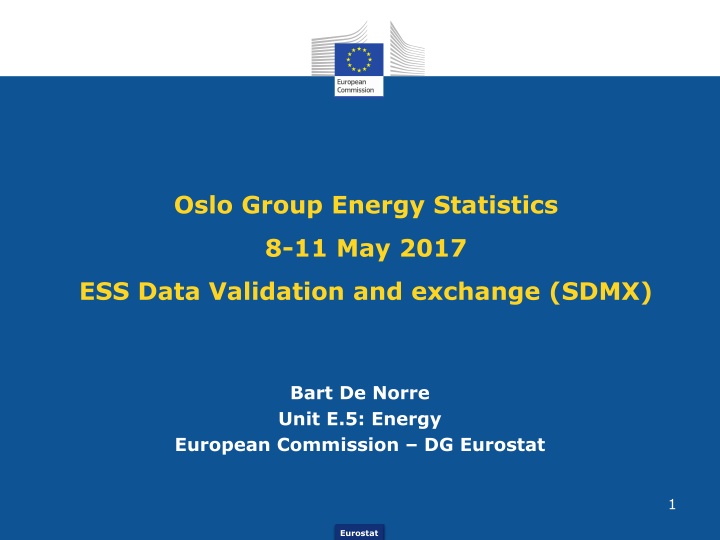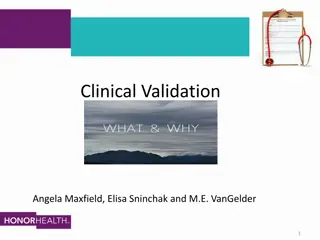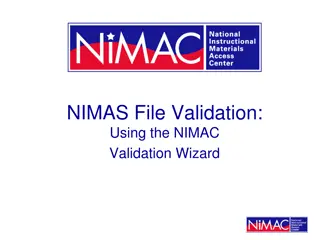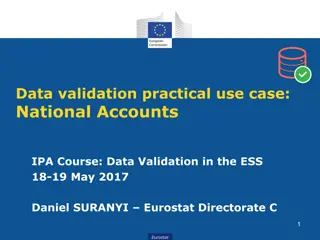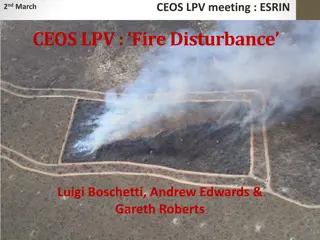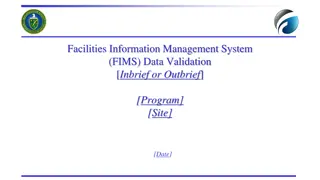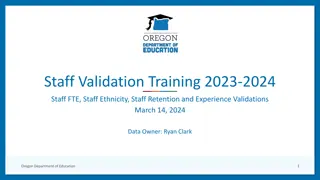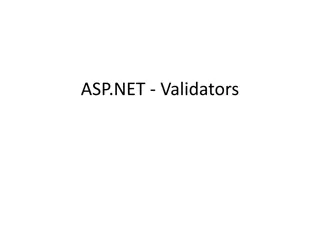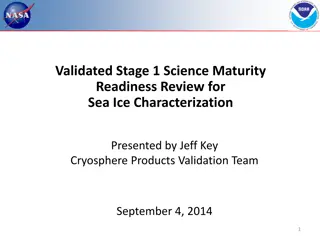Insights into European Energy Statistics and Data Validation
This document provides an overview of the Oslo Group Energy Statistics event held in May 2017, focusing on data validation, exchange processes, and future visions within the European energy sector. It covers key aspects such as regulations, quality standards, stakeholders, collaboration, standardization, and the role of IT in information processing and exchange. The content emphasizes the importance of standard practices and methodologies for ensuring accuracy, coherence, and timeliness of energy data across various domains.
Download Presentation

Please find below an Image/Link to download the presentation.
The content on the website is provided AS IS for your information and personal use only. It may not be sold, licensed, or shared on other websites without obtaining consent from the author.If you encounter any issues during the download, it is possible that the publisher has removed the file from their server.
You are allowed to download the files provided on this website for personal or commercial use, subject to the condition that they are used lawfully. All files are the property of their respective owners.
The content on the website is provided AS IS for your information and personal use only. It may not be sold, licensed, or shared on other websites without obtaining consent from the author.
E N D
Presentation Transcript
Oslo Group Energy Statistics 8-11 May 2017 ESS Data Validation and exchange (SDMX) Bart De Norre Unit E.5: Energy European Commission DG Eurostat 1 Eurostat
Overview Context ESS shared validation SDMX DSD Energy Eurostat ESS Future 2 Eurostat
Context European Energy Statistics: Energy Statistics Regulations Regulation 223/2009 on European statistics Content, Quality, Responsibilities (MS, Eurostat) International: IEA/EUROSTAT/UNECE data collections IRES / SIEC Common data needs / methodology (validation) / reporting Eurostat and the ESS the ESS Vision 2020 ESS global policies / standards / projects (all domains) together Eurostat, the ESS and world wide SDMX 3 Eurostat
Context Quality: Criteria / Code of practice (accuracy, coherence, timeliness, cost-effectiveness) Content: data and metadata Processes Actors / stakeholders Communication and exchange Exchanges at many levels: countries international bodies, within country between different authorities; countries countries Reporting countries Most difficult part (subsidiarity / proportionality); many aspects in accuracy can only be done by collecting authorities; receiving aggregated data limits many accuracy checks to plausibility checks Increasing demands / stable or shrinking resources 4 Eurostat
Context Quality, the role of: Collaboration and mutual common understanding Formalising knowledge (data, metadata and validation logic) Who does what (formalising responsibilities) Information processing (IT) Facilitating exchange at collection, at dissemination (push/pull) Standardisation 5 Eurostat
Context Standardisation: content (data, code lists, definitions and other domain methodology) methodology (validation typology and logic) business processes (GSBPM) generic outcomes (validation reports) information system design, IT "technology" within a domain / across domains (using/comparing data across several domains) understanding and applying similar "standardised" approaches is especially useful for NSI and Eurostat working in many domains ("industrial statistical processing"; metadata driven generic IT processes) Economics of scale 6 Eurostat
Context Eurostat / ESS global objectives for ESS shared validation and SDMX: increase Effectiveness (result) Efficiency (process) Related projects to a higher quality at a lower cost: less errors, more certainty and more timely outcomes reduction in resources and elimination of redundant actions. A few examples of targeted changes: validation comprising rules which are formally adopted by all ESS stakeholders; sharing the same understanding via standards and more formalised knowledge; a more automatized validation process with clear responsibilities and avoiding multiple iterations (ping-pong) 7 Eurostat
ESS shared validation The idea: collaborative approach of sharing validation between countries and Eurostat in fact, is this principle so new? Major objectives: increasing transparency and clarity (shared and easily accessible documentation on validation procedures); effectiveness of the validation (the appropriate rules by the responsible authority close at the source, awareness of all possible errors and warnings, avoiding validation gaps, avoiding double work) efficiency (avoiding the number of iterations between sending validating requesting new sending) efficiency in the information processing and communication (The lack of common standards for validation solutions leads to a duplication of IT development and integration costs in the ESS). 8 Eurostat
ESS shared validation ESSC May 2016: "agreement and documentation at Working Group level of validation rules and responsibilities" Mandatory! "Use of shareable and reusable ESS services to validate data" What does this imply Common validation policy / methodology / typology validation levels Validation responsibilities Validation rules and severity Improving inter-operability 9 Eurostat
ESS shared validation Validation typology 10 Eurostat
ESS shared validation How and who Basic principles Design data structures Design validation rules (and severity level) A full description and agreement on the validation rules and their associated severity for each data collection Validate data: 2 major steps/ actors (reporting country, Eurostat) An agreement on the responsibility of each national reporting organisation to perform the agreed validation rules before Long term process / in steps / Taskforce 11 Eurostat
ESS shared validation 12 Eurostat
ESS shared validation Scenario: Autonomous / Interoperable validation services 13 Eurostat
ESS shared validation Scenario: Replicated/Shared validation services 14 Eurostat
ESS shared validation Scenario: shared validation process 15 Eurostat
ESS shared validation 16 Eurostat
SDMX Statistical data and metadata exchange SDMX adopted and used more and more in ESS Organisational context and logistics Developments for energy statistics (Supply transformation consumption; Electricity and gas prices) 17 Eurostat
SDMX Common open standards for data and metadata accepted worldwide for exchanging and sharing statistical information and as a general basis for statistical infrastructures. Started in 2001 by seven international organisations (BIS, ECB, Eurostat, IMF, OECD, UN and World Bank) ISO standard (ISO 17369:2013) SDMX Roadmap 2020 (March 2016): Strengthening implementation of SDMX Making data usage easier via SDMX Using SDMX to modernise statistical processes Better communication and capacity-building (including interaction with ESS Vision 2020 and UNECE modernisation of official statistics) 18 Eurostat
SDMX Promoted by the European Statistical System Policy and big enabler for the ESS VISION 2020 reduce data errors improve timeliness improve accessibility improve interpretability improve coherence reduce the reporting burden reduce IT development and maintenance costs (with open source approach, shared toolbox and improved interpretability). For future IT development: standards independent of domain specific structures "If each partner system were to use SDMX data structures and common IT building blocks, international information systems would be able to communicate machine-to-machine as in industrial production processes." ESSC: SDMX one of the non-legislative normative documents to be recognised as ESS standards 19 Eurostat
SDMX Use of SDMX in Eurostat ESS statistical domains 40% of European statistical production processes are now describing their data structures using the SDMX standards and concepts. ESS: 26 SDMX implementation projects, related to about (38%) of all the data sets that Eurostat receives through EDAMIS Further increase: 2016: +10; 2017: +4 GLOBAL DSD: 5 https://webgate.ec.europa.eu/fpfis/mwikis/sdmx/index.php/SDMX_DSD_ availability 20 Eurostat
SDMX statistical content and the information processing (IT) perspectives Standards on logical and technical level: "Content" "Container" Development of SDMX artefacts according SDMX methodology, guidelines and concepts For example information model, content oriented guidelines, cross-domain concepts Use of SDMX objects by generic programs/services "Embed logic in data objects" 21 Eurostat
SDMX Organisation and logistics International agreement <= SDMX secretariat Support and management by SDMX IT architecture and tools for example a central repository (Euro SDMX registry) Maintenance responsibility by a selected international agency 22 Eurostat
SDMX For Energy Statistics: Supply-consumption chain => "semi-global" DSD development with IEA Firstly collection/validation/production process Afterwards dissemination Eurostat DSD on Prices Firstly DSD (data structure definition) Afterwards MSD (metadata structure definition) Still later: use of VTL (Validation and Transformation Language) 23 Eurostat
DSD Energy statistics Supply-Consumption chain: Joint annual data collections (JAQ) of IEA-Eurostat-UNECE; monthly data collections (joint, IEA, Eurostat) IRES and SIEC International / Standards / Classification(s) SDMX guidelines: MODELLING A STATISTICAL DMAIN FOR DATA EXCHANGE IN SDMX https://sdmx.org/wp-content/uploads/Modelling-domain-SDMX-discussion-paper- v1-201503.pdf THE DESIGN OF DATA STRUCTURE DEFINITIONS https://sdmx.org/wp-content/uploads/SDMX_Guidelines_for_DSDs_1.0.pdf THE CREATION AND MANAGEMENT OF SDMX CODE LISTS http://sdmx.org/wp-content/uploads/SDMX_Guidelines_for_CDCL.doc 24 Eurostat
DSD Energy statistics Joint development Eurostat - IEA IEA had done work in 2009-2012 Eurostat proposed IEA in May 2015 to take up together DSD development Series of video conferences / mail exchanges since October 2015 Explanatory document + Inventory code lists Testing DSD mapping with some questionnaires on-going Gradual verification/update (revised monthly coal, new monthly electricity, revised JAQ 2017) 25 Eurostat
DSD Energy statistics Concepts in the energy domain Definition (concept code name and description) Role (dimension, primary measure, attribute) Level (attribute relevant at observation, series or dataset level) usage status (mandatory or conditional/optional attributes) code list / format 26 Eurostat
DSD Energy statistics Dimensions / structural principles (SDMX guidelines) 1. Parsimony: no redundant dimensions for identifying 2. Simplicity: keep identifiers short / keep number of dimensions low 3. Purity: dimensions relate to one pure concept, not to a combination 4. Density and sparseness ("not available" values in the dimension combinations) 5. Unambiguousness (avoid one observation to be expressed by multiple combinations of dimension values (keys)) 6. Exhaustiveness (includes every piece of information that is required to unambiguously represent a data point and to correctly interpret it outside its usual context) 27 Eurostat
DSD Energy statistics 7. Orthogonality: independence of the meaning of a value of one dimension from the values of any other dimensions 8. User friendliness (While a simple DSD consisting of a few dimensions only may be easier to understand by a human data consumer, a more complex, but purer DSD is typically more flexible in terms of further usage in automated processes.) 9. Fitness for use throughout the entire statistical business process Re-use concepts / code lists (frequency, observation status) Extensible for potential future needs 28 Eurostat
DSD Energy statistics Further design principles: designed independently of the layout or technical features of existing EXCEL questionnaires and database structures in place at IEA and Eurostat one DSD which is based on a clear logical model and flexible enough to cover all data and metadata from all concerned questionnaires "Remarks" sheets (Attribute "COMMENT_OBS"; explanatory "free text" to future MSD) 29 Eurostat
DSD Energy statistics 14 DIMENSIONS (identifying concepts) 1. 2. 3. 4. 5. 6. 7. 8. 9. 10. STOCKS 11. INFRASTRUCTURE_IND 12. VIS_A_VIS_AREA 13. MEASURE_VALUE_TYPE 14. FACILITY_ID QUEST_SOURCE REF_AREA TIME_PERIOD FREQ ENERGY_PRODUCT MAIN_FLOW FLOW_BREAKDOWN PLANT_TECH PLANT_TYPE 30 Eurostat
DSD Energy statistics REF_AREA SDMX promotes one code list across SDMX domains Based on the one of National Accounts ENERGY_PRODUCT all primary and secondary energy products or commodities and their aggregates as used in the energy questionnaires (and energy balances) Align to SIEC SIEC doesn't contain all our products Align to SDMX code list guidelines Codes based on SIEC hierarchical numbering 31 Eurostat
DSD Energy statistics MAIN_FLOW and FLOW_BREAKDOWN two-level hierarchical approach according IRES codes for MAIN_FLOW 1. Production 2. Net production (of electricity or heat) 3. Gross production (of electricity or heat) 4. Imports 5. Exports 6. International marine bunkers 7. International aviation bunkers 8. Stocks 9. Transfers 10. Supply 10. Statistical differences 11. Demand 12. Transformation 13. Consumption 14. Energy use 15. Non-energy use 16. Losses Around 110 codes for FLOW_BREAKDOWN 32 Eurostat
DSD Energy statistics MAIN_FLOW and FLOW_BREAKDOWN Many main flows are split in more detailed flows There are multiple electricity and heat production flows because of all possible energy input, plant technologies and plant types. Stock changes apply to a broad diversity of types of stocks Import and export flows are detailed by the country/region from where is imported resp. the country/region to where is exported For some detailed flows additional dimensions are needed: PLANT_TECH PLANT_TYPE STOCKS VIS_A_VIS_AREA. 33 Eurostat
DSD Energy statistics PLANT_TECH: technologies used in plants for production of electricity and / or heat This code list is not a straight hierarchical classification: different perspectives are used in classifying/grouping power and heat plants (product based, single/multi-fired, and technical type of generation) COMBFUEL - Combustible Fuels; HYDRO - Hydro (all, unspecified) PLANT_TYPE: MAINELEC - Main Activity Producer Electricity Plants main classification of electricity and heat plants INFRASTRUCTURE_IND: A number of data in the questionnaires describe infrastructure characteristics GROSSCAP - Gross capacity (of electricity and/or heat); SOLARSUR - Solar collectors surface 34 Eurostat
DSD Energy statistics MEASURE_VALUE_TYPE several measurement concepts used in reporting of energy data values ENERGY Measure of Heat or Electricity; NCV Net Calorific Value VIS_A_VIS_AREA (COUNTERPART_AREA) FACILITY_ID an identifier key for the storage locations for gas and refineries (from the JAQ 2017 onwards) 35 Eurostat
DSD Energy statistics OBS_VALUE 6 ATTRIBUTES: UNIT_MEASURE KT Kilotonne; TJ_NCV - TeraJoule (NCV) OBS_STATUS (SDMX Standard) normal, missing, estimated CONF_STATUS (SDMX Standard) SUBMISSION (date of the submission of the questionnaire) COMMENT_OBS (short free text related to one or more observations, dataset) FACILITY_TYPE (types of gas storage facilities and refineries) FACILITY_NAME 36 Eurostat
SDMX SIEC based code list ENERGY_PRODUCT SIEC SIEC based for DSD C0000 aggregation formula Section Division Group 0 class SIEC label Coal C0000 = C0100 +C0200 + C0300 + C0370 + C0390 C0100 = C0110 + C0120 C0100 01 Hard coal C0110 C0120 011 012 0110 Anthracite Bituminous coal C0120 = C0121 + C0129 C0121 C0129 C0200 0121 0129 Coking coal Other bituminous coal Brown coal C0200 = C0210 + C0220 02 C0210 C0220 C0300 021 022 03 0210 0220 Sub-bituminous coal Lignite Coal products C0300 = C0310 + C0320 +C0330 + C0340 + C0350 +C0360 C0310 = C0311 + C0312 +C0313 + C0314 C0310 031 Coal coke C0311 C0312 0311 0312 Coke oven coke Gas coke 37 Eurostat
Example monthly coal 38 Eurostat
Example monthly coal 39 Eurostat
Example monthly electricity 40 Eurostat
Example monthly electricity 41 Eurostat
Example monthly electricity 42 Eurostat
Example monthly electricity 43 Eurostat
Eurostat ESS future A full global ESS Shared Validation / SDMX implementation is a long term issue Awareness and knowledge building is highly needed Well informed, active participation to be able to endorse together a realistic planning Before real production some pilot projects with volunteering countries are needed Implementation shall take place in steps over years Avoid burden in the transition phases for reporting countries Allow options for "fast implementers" 44 Eurostat
Eurostat ESS future "ESWG Task Force on the implementation of ESS shared validation and SDMX " the development and review of data structures definitions, code lists and other SDMX artefacts (including their validation and testing) development and assessment of the implementation (including timeline for the implementation) establishment of specific operational guidelines for the energy domain, including links to the ESS shared validation prepare and advise on recommended actions and implementations for the ESWG meetings 45 Eurostat
Bart.Denorre@ec.europa.eu 46 Eurostat
